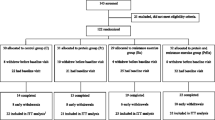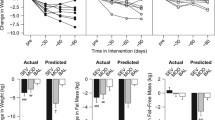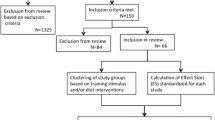Summary
Obese individuals have excess total body mass, a condition resulting from an overaccumulation of both fat and fat free mass (FFM). Research has been focusing on the need to maintain FFM during weight loss because of its integral role in metabolic rate regulation, preservation of skeletal integrity and maintenance of functional capacity. It has been suggested that FFM loss should compose no more than 30% of total weight loss. Because skeletal muscle in the obese has been shown to consist of an increased amount of low density muscle tissue, impaired strength: size ratio, less capillarisation, decreased mitochondrial density, and consequently impaired work capacity, it may be necessary to stratify FFM into essential and less essential FFM categories. With this categorisation, more specific quantification of FFM loss and maintenance can be made. While FFM influences several physiological functions, it may be that a minimal loss of FFM from the obese state is not only unavoidable, but actually desirable if the loss is in the form of less essential FFM.
Similar content being viewed by others
References
Marks BL, Ward A, Morris DH, et al. Fat-free mass is maintained in women following a moderate diet and exercise program. Med Sci Sports Exerc 1995; 27: 1243–51
Wadstrom C, Larsson L, Knutsson E, et al. The effect of excessive weight loss on skeletal muscle in man. Eur J Surg 1991; 157: 347–54
Donnelly JE, Jakicic J, Gunderson S. Diet and body composition: effect of very low calorie diets and exercise. Sports Med 1991; 12(4): 237–49
Bray GA. Exercise and obesity. In: Bouchard C, Shepard R, Stephens T, et al., editors. Exercise, fitness, and health: a consensus of current knowledge. Philadelphia: Human Kinetics, 1990: 497–510
Van Dale D, Saris WHM, Ten Hoor F. Weight maintenance and resting metabolic rate 18–40 months after a diet/exercise treatment. Int J Obes 1990; 14: 347–59
Cunningham JJ. Body composition as a determinant of energy expenditure: a synthetic review and a proposed general prediction equation. Am J Clin Nutr 1991; 54: 963–9
Aloia JF, Vaswani A, Ma R, et al. To what extent is bone mass determined by fat-free or fat mass? Am J Clin Nutr 1995; 61: 1110–4
Svendsen OL, Hassager C, Christiansen C. Effect of an energy-restrictive diet, with or without exercise, on lean tissue mass, resting metabolic rate, cardiovascular risk factors, and bone in overweight postmenopausal women. Am J Med 1993; 95: 131–40
Dutta C, Hadley EC. The significance of sarcopenia in old age. J Gerontol Biol Sci Med Sci 1995; 50A: 1–4
Blanchard J, Conrad KA, Harrison GG. Comparison of methods for estimating body composition in young and elderly women. J Gerontol Biol Sci 1990; 45: B119–24
Lohman TG. Advances in body composition assessment. Current issues in exercise science series, monograph No. 3. Champaign: Human Kinetics, 1992; 1–56
Spirduso W. Physical dimensions of aging. Philadelphia: Human Kinetics, 1995; 57–91
Siri WE. Body composition from fluid spaces and density: analysis of methods. In: Brozek J, Henschel A, editors. Techniques for measuring body composition. Washington, DC: National Academy of Sciences, 1961: 223–44
Brozek J, Grande F, Anderson JT, et al. Densitometric analysis of body composition: revision of some quantitative asumptions. Ann NY Acad Sci 1963; 110: 113–40
Campbell WW, Crim MC, Young VR, et al. Increased energy requirements and changes in body composition with resistance training in older adults. Am J Clin Nutr 1994; 60(2): 167–75
McArdle WD, Katch FI, Katch VL. Exercise physiology: energy, nutrition, and human performance. 4th ed. Baltimore: Williams and Wilkins, 1996; 53–68
Lightfoot JT, Torok DJ, Marks BL. Near infrared interactance does not accurately measure body fat in field conditions [abstract no. 16]. 23rd Annual Meeting of the Southeast American College of Sports Medicine; 1995 Feb 2–4: Lexington (KY)
Bioelectrical impedance analysis in body composition measurement. National Institutes of Health Technol Assess Statement; 1994 Dec 12–14; 1–35
Kenney WL, Buskirk ER. Functional consequences of sarcopenia: effects on thermoregulation. J Gerontol Biol Sci Med Sci 1995; 50A: 78–85
Marks BL, Perkins KA. The effects of nicotine on metabolic rate. Sports Med 1990; 10(5): 277–85
Leibel RL, Rosenbaum M, Hirsch J. Changes in energy expenditure resulting from altered body weight. N Engl J Med 1995; 332: 621–8
Kreitzman SN, Coxon AY, Johnson PG, et al. Dependence of weight loss during very-low-calorie diets on total energy expenditure rather than on resting metabolic rate, which is associated with fat-free mass. Am J Clin Nutr 1992; 56 Suppl.: 258S–61S
Sum CF, Wang KW, Choo DC, et al. The effect of a 5-month supervised program of physical activity on anthropometric indices, fat-free mass, and resting energy expenditure in obese male military recruits. Metabolism 1994; 43: 1148–52
Heshka S, Yankg M, Wang J, et al. Weight loss and change in resting metabolic rate. Am J Clin Nutr 1990; 52: 981–6
Busetto L, Perini P, Giantin V, et al. Relationship between energy expenditure and visceral fat accumulation in obese women submitted to adjustable silicone gastric banding (ASGB). Int J Obes 1995; 19: 227–33
Guyton AC, Hall JE. Textbook of medical physiology. 9th ed. Philadelphia: Saunders, 1996: 73, 906–22
Taafe DR, Pruitt L, Lewis B, et al. Dynamic muscle strength as a predictor of bone mineral density in elderly women. J Sports Med Phys Fitness 1995; 35: 136–42
Shephard R, Bouhlel E, Vandewalle H, et al. Muscle mass as a factor limiting physical work. J Appl Physiol 1988; 64: 1472–9
Fleg J, Lakatta E. Role of muscle loss in the age associated reduction in V̇O2max. J Appl Physiol 1988; 65: 1147–51
Frontera W, Meredith C, O’Reilly K, et al. Strength conditioning in older men: skeletal muscle hypertrophy and improved function. J Appl Physiol 1988; 64: 1038–44
Malina RM. Growth, exercise, fitness, and later outcomes. In: Bouchard C, Shepard R, Stephens T, et al., editors. Exercise, fitness, and health: a consensus of current knowledge. Philadelphia: Human Kinetics, 1990: 637–53
Webster JD, Hesp R, Garrow JS. The composition of excess weight in obese women estimated by body density, total body water, and total body potassium. Hum Nutr Clin Nutr 1984; 38C: 299–306
Bailor DL, Poehlman ET. Exercise-training enhances fat-free mass preservation during diet-induced weight loss: a metaanalytical finding. Int J Obes 1994; 18: 35–40
Forbes G, Welle S. Lean body mass in obesity. Int J Obes 1983; 7: 99–107
Kelley DE, Slasky BS, Janosky J. Skeletal muscle density: effects of obesity and non-insulin-dependent diabetes mellitus. Am J Clin Nutr 1991; 54: 509–15
Kirkwood SP, Zurlo F, Larson K, et al. Muscle mitochondrial morphology, body composition, and energy expenditure in sedentary individuals. Endocrinol Metab 1991; 23: E89–94
Garfinkel PE, Coscina DV. Discussion: exercise and obesity. In: Bouchard C, Shepard R, Stephens T, et al., editors. Exercise, fitness, and health: a consensus of current knowledge. Philadelphia: Human Kinetics, 1990: 511–5
Donnelly JE, Sharp T, Houmard J, et al. Muscle hypertrophy with large-scale weight loss and resistance training. Am J Clin Nutr 1993; 58: 561–5
Kempen K, Sarris W, Westerterp KR. Energy balance during an 8-wk energy-restricted diet with and without exercise in obese women. Am J Clin Nutr 1995; 62: 722–9
Leutholtz BC, Keyser RE, Heusner WW, et al. Exercise training and severe caloric restriction: effect on lean body mass in the obese. Arch Phys Med Rehabil 1995; 76: 65–70
Pronk NP, Donnelly JE, Pronk SJ. Strength changes induced by extreme dieting and exercise in severely obese females. J Am Coll Nutr 1992; 11(2): 152–8
Ross R, Pedwell H, Rissanen J. Effects of energy restriction and exercise on skeletal muscle and adipose tissue in women as measured by magnetic resonance imaging. Am J Clin Nutr 1995; 61: 1179–85
Walberg JL. Aerobic exercise and resistance weight training during weight reduction. Sports Med 1989; 47: 343–56
Zhang Y, Proenca R, Maffei M, et al. Positional cloning of the mouse obese gene and its human homologue. Nature 1994; 332: 425–32
Lindpaintner K. Clinical implications of basic research: finding an obesity gene — a tale of mice and man. N Engl J Med 1995; 332: 679–80
Author information
Authors and Affiliations
Rights and permissions
About this article
Cite this article
Marks, B.L., Rippe, J.M. The Importance of Fat Free Mass Maintenance in Weight Loss Programmes. Sports Med 22, 273–281 (1996). https://doi.org/10.2165/00007256-199622050-00001
Published:
Issue Date:
DOI: https://doi.org/10.2165/00007256-199622050-00001




